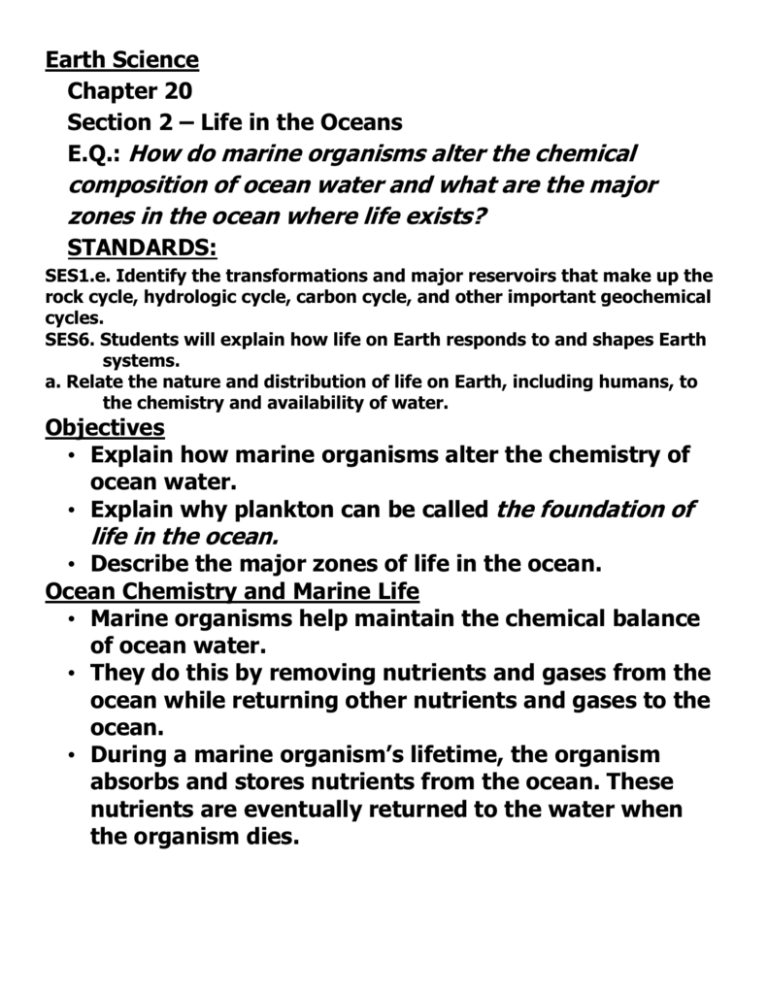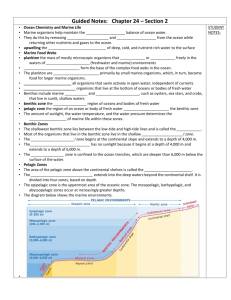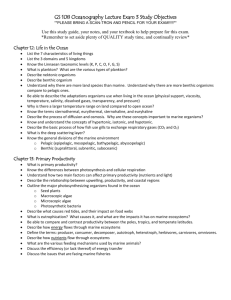Chapter 20
advertisement

Earth Science Chapter 20 Section 2 – Life in the Oceans E.Q.: How do marine organisms alter the chemical composition of ocean water and what are the major zones in the ocean where life exists? STANDARDS: SES1.e. Identify the transformations and major reservoirs that make up the rock cycle, hydrologic cycle, carbon cycle, and other important geochemical cycles. SES6. Students will explain how life on Earth responds to and shapes Earth systems. a. Relate the nature and distribution of life on Earth, including humans, to the chemistry and availability of water. Objectives • Explain how marine organisms alter the chemistry of ocean water. • Explain why plankton can be called the foundation of life in the ocean. • Describe the major zones of life in the ocean. Ocean Chemistry and Marine Life • Marine organisms help maintain the chemical balance of ocean water. • They do this by removing nutrients and gases from the ocean while returning other nutrients and gases to the ocean. • During a marine organism’s lifetime, the organism absorbs and stores nutrients from the ocean. These nutrients are eventually returned to the water when the organism dies. Sea ocean bacteria Stromatolites are layered, mushroom-shaped structures formed by lime secreted by cyanobacteria. Fossilized stromatolites have provided scientists with critical information about the earliest development of life on Earth. Living stromatolites are among the unique forms of life in the ocean. Some marine bacteria can interact with diatoms, another type of marine microbe, in such a way that influences the cycling of silicon in the ocean. Diatoms, a group of unicellular algae, are characterized by their highly ornate two-part shell-like structures made from silica. Read more: Microbes in the Ocean - sea, oceans, effects, temperature, important, types, plants, source, marine, oxygen, human, Pacific http://www.waterencyclopedia.com/Mi-Oc/Microbes-in-theOcean.html#ixzz1rgavpUX3 Upwelling upwelling - the movement of deep, cold, and nutrient-rich water to the surface • In general, all of the elements necessary for life are consumed by organisms near the surface. • Elements are then released back into the ocean water when organisms die, sink to lower depths, and decay. Thus, deep water is a storage area for nutrients needed for life. Marine Food Webs plankton - the mass of mostly microscopic organisms that float or drift freely in the waters of aquatic (freshwater and marine) environments • Plankton form the base of the complex food webs in the ocean. An amphipod (Hyperia macrocephala) a type of crustacean - there are more than 7,000 different types of amphipods Deep water decapod - a type of crustacean nekton - all organisms that swim actively in open water, independent of currents Basking shark that eats plankton - The basking shark (Cetorhinus maximus) is the second largest living fish, after the whale shark. It has long been a commercially important fish, as a source of food, shark fin, animal feed, and shark liver oil. Overexploitation has reduced its populations to the point that some have apparently disappeared and others need protection. Its total length is 12.27 meters (40.3 ft). The whale shark, Rhincodon typus, is a slow-moving filter feeding shark and the largest extant fish species. The largest confirmed individual had a length of 12.65 meters (41.50 ft). benthos - organisms that live at the bottom of oceans or bodies of fresh water • The plankton are consumed primarily by small marine organisms, which, in turn, become food for larger marine organisms. Octopuses of the genus Grimpoteuthis are also known as "Dumbo octopuses". They are benthic creatures, living at extreme depths: 3000-4000 meters, and are some of the rarest of the Octopoda species. Ocean Environments benthic zone - the bottom region of oceans and bodies of fresh water Southern stingray Angler fish pelagic zone - the region of an ocean or body of fresh water above the benthic zone • The amount of sunlight, the water temperature, and the water pressure determines the distribution of marine life within these zones. • The area of the pelagic zone above the continental shelves is called the neritic zone. • The oceanic zone extends into the deep waters beyond the continental shelf. It is divided into four zones, based on depth. • The epipelagic zone is the uppermost area of the oceanic zone. The mesopelagic, bathypelagic, and abyssopelagic zones occur at increasingly greater depths. The pelagic zone can also be called the open-ocean zone. The pelagic zone can also be divided into sections making several subzones based on the different ecological characteristics. They are mostly divided by depth. Epipelagic • The epipelagic zone is located from the surface of the water down to around 200 meters. This zone is known for many varieties of photosynthetic life because of the abundant sunlight. This zone is where there are a large concentration of fish including tuna, sharks, • and dolphin fish. Jellies are also very abundant in this location because of the large amount of other fish in the area. Tuna Great white shark Dolphin fish Nomura's jellyfish Mesopelagic • The mesopelagic zone is located from about 200meters to around 1,000 meters. Some light does make it down this far but it is not sufficient enough for photosynthetic animals to thrive. Animals that are located here include swordfish, squid, and a few species of cuttlefish. Some other semi-deep-sea creatures can also be found here. Swordfish Squid Bathypelagic • The Bathypelagic zone is located from 1,000 meters to about 4,000 meters. This zone of the ocean is almost entirely in the dark because the light cannot penetrate this deep. Many of the animals that live in this zone have adapted to the environment by having bioluminescent structures on their body. An example of such a creature is a lantern fish. Most of the animals that are located here are carnivores or feed on the dead material that falls down from the other zones of the pelagic zone. Giant squid are also known to live in this zone as well as the dumbo octopus. Giant squid Lantern fish Abyss pelagic • The abyss pelagic zone is located from about 4,000 meters to just above the ocean floor. This zone is completely dark because no light is able to penetrate to this depth. Most creatures in this zone are blind and colorless or shades of red. The organisms are red because no red light is able to penetrate down making them well camouflaged in the dark. Mantis shrimp This highly intelligent hunter with claws can lash out at prey with the force of a gunshot. Larger varieties have been known to shatter glass or sever human fingers. Most are either “spearers” (with sharp, mantidlike claws) or “smashers” (with blunt, clublike claws for cracking hard-shelled prey). Rare among invertebrates are the monogamous mating habits that several species demonstrate. Mated pairs share a burrow, and the male hunts for both his mate and young. Hadopelagic • The hadopelagic zone is located in deep water in ocean trenches. Little is known about this zone and very few species are known to live there. Many of the organisms that do live here are located near hydrothermal vents. Some organisms that live here include Giant tube worms. Giant tube worms Benthic Zones • The shallowest benthic zone lies between the low-tide and high-tide lines and is called the intertidal zone. • Most of the organisms that live in the benthic zone live in the shallow sublittoral zone. • The bathyal zone begins at the continental slope and extends to a depth of 4,000 m. • The abyssal zone has no sunlight because it begins at a depth of 4,000 m and extends to a depth of 6,000 m. • The hadal zone is confined to the ocean trenches, which are deeper than 6,000 m below the surface of the water. READING CHECK Which benthic zone has the most marine life? Why? Most marine life is found in the sublittoral zone. Life in this zone is continuously submerged, but waters are still shallow enough to allow sunlight to penetrate. The diagram below shows the marine environments.







